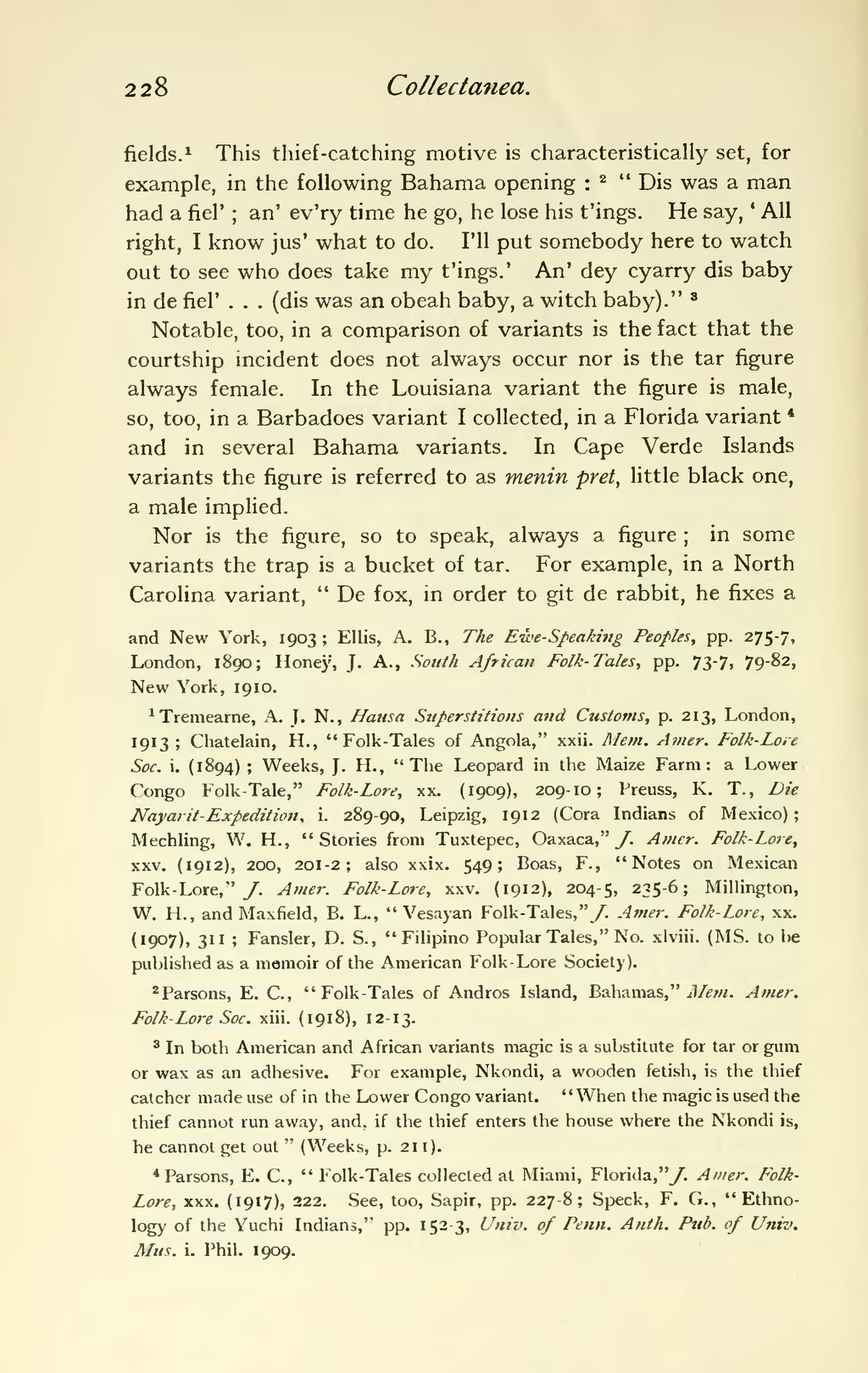fields.[1] This thief-catching motive is characteristically set, for example, in the following Bahama opening:[2] "Dis was a man had a fiel'; an' ev'ry time he go, he lose his t'ings. He say, 'All right, I know jus' what to do. I'll put somebody here to watch out to see who does take my t'ings.' An' dey cyarry dis baby in de fiel' … (dis was an obeah baby, a witch baby)."[3]
Notable, too, in a comparison of variants is the fact that the courtship incident does not always occur nor is the tar figure always female. In the Louisiana variant the figure is male, so, too, in a Barbadoes variant I collected, in a Florida variant[4] and in several Bahama variants. In Cape Verde Islands variants the figure is referred to as menin pret, little black one, a male implied.
Nor is the figure, so to speak, always a figure; in some variants the trap is a bucket of tar. For example, in a North Carolina variant, "De fox, in order to git de rabbit, he fixes a
- ↑ Tremearne, A. J. N., Hausa Superstitions and Customs, p. 213, London, 1913; Chatelain, H., "Folk-Tales of Angola," xxii. Mem. Amer. Folk-Lore Soc. i. (1894); Weeks, J. H., "The Leopard in the Maize Farm: a Lower Congo Folk-Tale," Folk-Lore, xx. (1909), 209-10; Preuss, K. T., Die Nayarit-Expedition, i. 289-90, Leipzig, 1912 (Cora Indians of Mexico); Mechling, W. H., "Stories from Tuxtepec, Oaxaca," J. Amer. Folk-Lore, xxv. (1912), 200, 201-2; also xxix. 549; Boas, F., "Notes on Mexican Folk-Lore," J. Amer. Folk-Lore, xxv. (1912), 204-5, 235-6; Millington, W. H., and Maxfield, B. L., "Vesayan Folk-Tales," J. Amer. Folk-Lore, xx. (1907), 311; Fansler, D. S., "Filipino Popular Tales," No. xlviii. (MS. to be published as a memoir of the American Folk-Lore Society).
- ↑ Parsons, E. C., "Folk-Tales of Andros Island, Bahamas," Mem. Amer. Folk-Lore Soc. xiii. (1918), 12-13.
- ↑ In both American and African variants magic is a substitute for tar or gum or wax as an adhesive. For example, Nkondi, a wooden fetish, is the thief catcher made use of in the Lower Congo variant. "When the magic is used the thief cannot run away, and, if the thief enters the house where the Nkondi is, he cannot get out" (Weeks, p. 211).
- ↑ Parsons, E. C., "Folk-Tales collected at Miami, Florida," J. Amer. Folk-Lore, xxx. (1917), 222. See, too, Sapir, pp. 227-8; Speck, F. G., "Ethnology of the Yuchi Indians," pp. 152-3, Univ. of Penn. Anth. Pub. of Univ. Mus. i. Phil. 1909.
and New York, 1903; Ellis, A. B., The Ewe-Speaking Peoples, pp. 275-7, London, 1890; Honeÿ, J. A., South African Folk-Tales, pp. 73-7, 79-82, New York, 1910.
